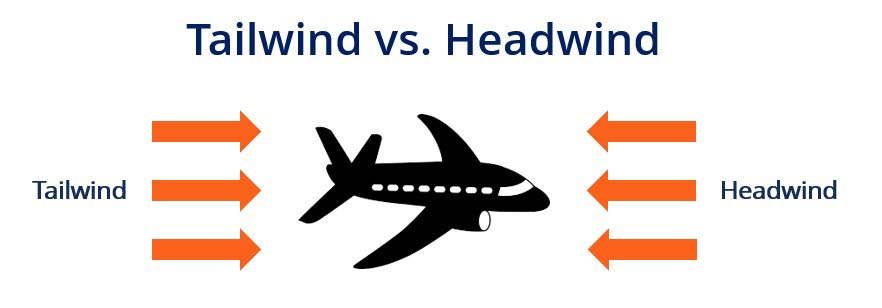Wind effects on aircraft flight

People who have travelled on a two-way trip from Port of Spain to Miami will have observed that the return flight takes less time, even though the aircraft speed on both flights is the same over the fixed ground distance of 1,394 nautical miles or 1,604 statute miles.
This is because of the winds the aircraft encounters during the flight.
On the flight from Port of Spain to Miami, the aircraft encounters headwinds which blow against the direction of the aircraft, resulting in its moving forward in a body of air that is moving backwards.
On the return flight, the aircraft encounters tailwinds moving in the same general direction as the aircraft, resulting in its moving forward in a body of air that is also moving forward.
The difference in the flight times in the two scenarios gives rise to the concepts of "airspeed" and" groundspeed," which are both expressed in knots.
The term “knot,” like other aviation terms, was imported from the maritime industry, which existed long before the aviation industry. The knot is a unit of speed equal to one nautical mile per hour, and was first used by sailors to calculate the speed of ships using a device called a “common log.”
The cruising speed of Boeing 737-800 aircraft is approximately 460 knots. Unlike miles per hour there is no such term as knots per hour, because a knot is defined as one nautical mile per hour.
A statue mile equals 5,250 feet. A nautical mile equals 6,076 feet, because it is based on the earth’s longitude and latitude co-ordinates, with one nautical mile equalling one minute of latitude, or one sixtieth of a degree of latitude. Therefore, in the aviation industry, distance is expressed as nautical miles and speed is expressed as knots.
The use of latitude and longitude co-ordinates is more practical for long-distance travel, as the curvature of the earth is a critical factor in accurately measuring distances. Aeronautical charts use latitude and longitude, as it is easier for aviators to measure distance with nautical miles, which follow the earth’s curvature.

When that aircraft travelling at an airspeed of 460 knots experiences a 15-knot headwind, the actual groundspeed of 445 knots is derived by subtracting the 15-knot headwind from the 460-knot airspeed. If the headwind for the entire flight of 1,394 nautical miles is constant at 15 knots, the flight time would be three hours and eight minutes.
On the other hand, if there is a constant 15-knot tail wind, the airspeed will remain at 460 knots, and the actual groundspeed of 475 knots is derived by adding the 15-knot tailwind to the 460-knot airspeed. In this case, the flight time would then be two hours and 56 minutes.
Therefore, the basic rule is that headwinds increase the flight time and tailwinds decrease the flight time.
The concept is similar to the moving platforms at major airports. If a passenger remains stationary on the platform, the passenger moves at the speed of the platform. If the passenger walks forward on the platform, he or she moves at the speed of the platform plus the walking speed.
All modern-day aircraft are equipped with a computerised air-data system that displays “real time,” the wind speed and wind direction on the cockpit primary flight display. The air-data system interfaces with the aircraft flight management computer to display the aircraft groundspeed “real time.”
For flight planning purposes, an aircraft fuel burn is expressed in pounds per hour and is based on the specific design characteristics of the engine. This information is contained in the aircraft flight plan and indicates the planned fuel burn between the way points on the flight route, based on altitude, outside temperature, weight of the aircraft, the wind speed and direction and other meteorological conditions forecast for the route. Pilots continually compare the actual fuel burn with the planned fuel burn to ensure there is adequate fuel remaining for the flight.
All aircraft have a maximum design takeoff weight which cannot be exceeded. Additionally, owing to environmental factors such as runway length, elevation and temperature, some aircraft have a regulated maximum takeoff weight.
When meteorological conditions forecast strong headwinds, the aircraft has to carry extra fuel because of the consequent increase in flying time. The weight of the aircraft, fuel, cargo and passengers cannot exceed the maximum takeoff weight. In order to compensate for extra fuel, the aircraft payload has to be decreased in order to comply with the takeoff weight limits. This is normally done by blocking off seats to limit the passenger capacity.
During the winter period, there are strong winds blowing from the north, and on some flights from Port of Spain to North American destinations, passenger seats are blocked off to enable extra fuel to be uplifted. In situations like these, when the flight is fully booked, the airline will ask passengers to volunteer to give up their seats in return for cash compensation and a seat on a later flight.

Comments
"Wind effects on aircraft flight"